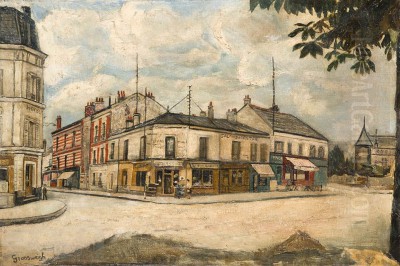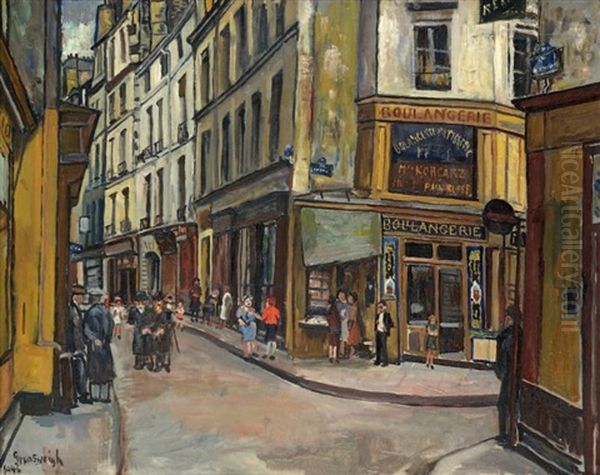
Nathan Grunsweigh (1880-1943) was a talented Polish-born painter who became an integral part of the vibrant international art scene in Paris during the early twentieth century. Associated with the famed École de Paris (School of Paris), Grunsweigh developed a distinctive style characterized by sensitive observation, evolving technique, and a poignant engagement with his surroundings. His life and promising career were tragically cut short during the Holocaust, but his work remains a testament to his artistic skill and his place within a crucial period of modern art history.
Early Life and Arrival in Paris
Born in Krakow, Poland, in 1880, Grunsweigh belonged to the generation of artists who sought creative freedom and opportunity beyond their homelands. Like many Eastern European artists, particularly those of Jewish heritage facing restrictions and pogroms, he was drawn to Paris, the undisputed capital of the art world at the time. He is believed to have settled in the French capital around the early 1900s, likely before the outbreak of World War I, immersing himself in the dynamic and competitive artistic environment of Montparnasse.
This period saw Paris teeming with artists from across the globe, all converging to learn, innovate, and make their mark. Grunsweigh arrived ready to absorb the influences of French modernism while bringing his own unique perspective, shaped by his Polish roots and experiences. His early years in Paris were likely dedicated to honing his craft, studying the works of masters both old and new, and finding his artistic voice amidst the city's bustling studios and cafes.
The École de Paris Context
Grunsweigh quickly became associated with the École de Paris, a term that describes not a formal institution, but rather the loose collective of foreign-born artists who flocked to Paris, particularly between the wars. This group was incredibly diverse, encompassing a wide range of nationalities, styles, and backgrounds. Figures like the Italian Amedeo Modigliani, the Lithuanian Chaïm Soutine, the Russian Marc Chagall, fellow Pole Moïse Kisling, and the Bulgarian Jules Pascin were among its most prominent members.

The École de Paris was characterized by its internationalism and its focus on figurative art, albeit often infused with modern sensibilities like Expressionism, Fauvism, or Cubism. These artists often congregated in the Montparnasse district, sharing studios, exhibiting together, and engaging in lively debates about the future of art. Grunsweigh found his place within this milieu, contributing to its energy and diversity while developing his personal artistic language. The environment fostered both collaboration and intense creative rivalry.
Artistic Style: Foundations and Evolution
Grunsweigh's art is often noted for its technical proficiency and sensitivity. His foundational style featured precise, confident lines and a flexible approach to composition. He possessed a keen eye for detail and structure, whether depicting the architecture of a Parisian street or the arrangement of objects in a still life. His color palette, particularly in earlier works, could be subtle and nuanced, demonstrating a sophisticated understanding of light and atmosphere.
Sources indicate that Grunsweigh's early work bore the influence of Post-Impressionism, suggesting an initial grounding in the French tradition of capturing light and everyday scenes. However, his style was not static. Over time, his work evolved, embracing more expressive techniques. His brushwork could become looser and more dynamic, and his use of color bolder, aligning him more closely with Expressionist tendencies prevalent among many École de Paris artists. This evolution shows an artist actively exploring different modes of representation.
Subject Matter: Landscapes and Cityscapes
Landscapes, both urban and rural, were a significant theme in Grunsweigh's oeuvre. He was particularly drawn to capturing the unique character of Paris and its environs. His cityscapes often depict specific locations, rendered with an eye for architectural detail but also imbued with a distinct mood. An example mentioned in auction records is Vincennes, la gare (Vincennes, the Station), an oil on panel measuring 39 x 49 cm, signed by the artist in the lower right corner. This work, typical of his interest in everyday urban scenes, carried an auction estimate of €1500 to €2000.
His depictions of Paris streets, such as the recurring subject of Montmartre (e.g., Rue Montmartre or Rue à Montmartre), showcase his ability to capture the bustling energy or quiet melancholy of the city. These works often combine his precise drawing with an increasingly expressive handling of paint, reflecting the life and atmosphere of the places he observed. His landscapes demonstrate a consistent engagement with the tangible world around him.
Subject Matter: Still Life and Figures

Still life painting was another important genre for Grunsweigh. Works like Vase de fleurs (Vase of Flowers), an oil on cardboard measuring 41 x 31.5 cm and signed lower left, demonstrate his skill in this area. Like Vincennes, la gare, this piece was estimated at €1500 to €2000 at auction. Another example is Nature morte à l'épicerie (Still Life at the Grocery), suggesting an interest in humble, everyday objects. His still lifes often reveal his careful attention to form, texture, and the interplay of light and shadow.
While perhaps less documented than his landscapes and still lifes, Grunsweigh also created portraits and figure studies. The painting Fillette lisant (Girl Reading) was exhibited as recently as 2020, indicating his work in this genre. Some sources also mention a thematic interest in "death of nature," which might relate to his still life compositions featuring wilting flowers or harvested produce, or perhaps landscapes depicting the changing seasons, adding a layer of melancholic reflection to his work.
A Key Work: Picnic in the Country
One particularly notable and poignant work is Picnic in the Country . This oil painting depicts a man, significantly shown wearing the compulsory Jewish star imposed during the Nazi occupation, holding a small knife. The background is described as dark and abstract, dominated by deep reds and browns, lending the scene a somber and intense atmosphere. This painting is a powerful testament to the artist's lived reality during the persecution of Jews in occupied France.
The inclusion of the Jewish star is a direct and courageous reference to the oppressive circumstances faced by Grunsweigh and his community. The abstract quality of the background further enhances the emotional weight of the scene, perhaps suggesting the encroaching darkness and uncertainty of the times. This significant work is held in the Ghez Collection at the University of Haifa in Israel, preserving a crucial piece of Holocaust-era art.
Exhibition Career and Recognition
Throughout his career in Paris, Grunsweigh actively exhibited his work, seeking visibility and recognition within the competitive art world. He participated in several major annual Salons, which were crucial platforms for artists to showcase their latest creations. Records show his participation in the Salon des Indépendants, known for its open-door policy welcoming avant-garde artists, the prestigious Salon des Tuileries, and the Salon de la Société des Artistes Modernes. Consistent participation in these Salons helped establish his reputation.
Beyond the large Salons, Grunsweigh was involved in specific group exhibitions. Notably, in 1941, during the German Occupation, he participated in the "Exhibition of Young Artists Under Twenty" (though Grunsweigh himself was older, the title likely referred to a spirit of modernity). This exhibition was organized by fellow artist Jean Bazaine and the publisher André Lefranc. Grunsweigh exhibited alongside prominent artists such as Fernand Léger, Marie Vassilieff, Marie David Seifert, George Kars, and Othon Friesz, demonstrating his continued connection to the Parisian art community even under duress.
Posthumous Attention and Market Presence
Interest in Nathan Grunsweigh's work has continued posthumously. A dedicated exhibition titled "Nathan Grunsweigh, Masters of the École de Paris" was held from May to September 2020 at the Konstancin-Jezior Art Center in Warsaw, Poland. This event highlights a renewed appreciation for his contribution to the École de Paris and brings his work back to the attention of audiences in his native country.
His paintings also appear periodically on the art market, indicating sustained interest from collectors. Auction results provide a glimpse into his market value. For instance, a version of Rue Montmartre reportedly sold for €1,200. As mentioned earlier, works like Vincennes, la gare and Vase de fleurs carried estimates between €1500 and €2000, while other pieces have appeared with estimates ranging from €600 upwards. This market presence confirms his status as a recognized, albeit perhaps undervalued, artist of his era.
Collaboration, Community, and Competition
Life within the École de Paris was characterized by a complex interplay of camaraderie and competition. Grunsweigh, like his contemporaries, benefited from the stimulating exchange of ideas and techniques. He likely formed friendships and professional relationships with fellow artists, sharing experiences as foreigners navigating the Parisian art scene. The Polish contingent in Paris was particularly strong, including artists like Moïse Kisling and Raymond Kanelba, whose stylistic trajectory might offer points of comparison with Grunsweigh's own development.
The collaborative spirit sometimes took concrete forms. Sources mention Grunsweigh's involvement, alongside Jean Bazaine and others, in clandestine artistic projects during the Occupation. This included decorating pillars and walls, possibly in locations like the Dôme café area or specific buildings (referred to obscurely as "Dome Fraux" and "Laffont building" in some sources). These acts can be seen as a form of artistic resistance or simply a way to continue creative practice under challenging conditions, fostering solidarity among artists. Other modern figurative artists active in Paris during this period included André Lhote and Marcel Gromaire.
Final Years and Deportation
The outbreak of World War II and the subsequent Nazi Occupation of Paris in 1940 brought devastating consequences for countless artists, especially those of Jewish descent like Nathan Grunsweigh. Anti-Semitic laws were implemented, restricting Jewish participation in public life, including the arts. Many artists fled, went into hiding, or joined the Resistance. Grunsweigh remained in Paris, continuing to work where possible, as evidenced by his participation in the 1941 exhibition.
However, the situation grew increasingly perilous. As the Nazi regime intensified its persecution, Jewish residents were systematically rounded up for deportation to concentration camps. Nathan Grunsweigh was arrested, likely during one of the major raids targeting Jews in Paris. He was deported, and tragically, records indicate he perished in the Auschwitz concentration camp in 1943. His death was a profound loss, silencing a unique artistic voice.
Legacy and Artistic Significance
Nathan Grunsweigh's legacy is that of a skilled and sensitive painter who contributed significantly to the rich tapestry of the École de Paris. His work reflects the artistic currents of his time, moving from Post-Impressionist influences towards a more personal, expressive style. He excelled in capturing the atmosphere of Parisian cityscapes and the quiet dignity of still life objects, often with a subtle melancholy undertone.
His later works, particularly Picnic in the Country, bear witness to the historical trauma he experienced, adding another layer of significance to his oeuvre. Though his career was tragically cut short, the surviving body of work reveals an artist of considerable talent and depth. He remains an important figure for understanding the diversity and vitality of the international art community in Paris in the first half of the twentieth century, and a poignant reminder of the human cost of war and persecution.
Conclusion
Nathan Grunsweigh stands as a notable Polish-Jewish artist of the École de Paris. His journey from Krakow to the heart of the Parisian art world, his stylistic evolution, his contributions through painting and exhibition, and his tragic end during the Holocaust form a compelling narrative. His works, characterized by technical skill, emotional resonance, and engagement with his surroundings, continue to be appreciated and ensure his place in the annals of twentieth-century European art. He represents one of the many distinctive voices that defined the unique artistic melting pot of Paris in its modern heyday.